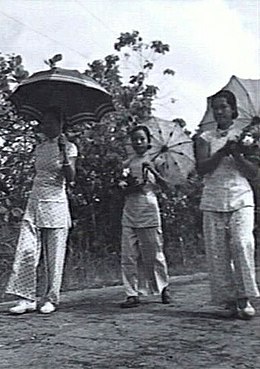
Back صينيو ماليزيا Arabic Chinesen in Malaysia German مالزیاییهای چینیتبار Persian Malesian kiinalaiset Finnish Chinois de Malaisie French Orang China Malaysia IBA Tionghoa-Malaysia ID Cino-malesi Italian 말레이시아 화교 Korean Малайз дахь хятадууд Mongolian
马来西亚华人 / 馬來西亞華人 Orang Cina Malaysia மலேசிய சீனர் | |
|---|---|
 | |
| Total population | |
| 6,712,200[1] 22.4% of the Malaysian population (2024)[2] | |
| Regions with significant populations | |
Penang, Kedah, Perlis, Kuala Lumpur, Perak, Selangor, Johor, and Sarawak Significant diaspora in: | |
| Languages | |
| Mandarin (lingua franca), Malay and English as medium of communication in schools and government Mothertongue languages: Hokkien, Cantonese, Hakka, Teochew, Fuzhou, Hainanese, Taishanese and Henghua; Manglish (creole) | |
| Religion | |
| Predominantly Mahāyāna Buddhism and Taoism (Chinese folk religion) • Minority Islam • Hinduism • Christianity • Non-religious • Other religions | |
| Related ethnic groups | |
| Bruneian Chinese · Singaporean Chinese · Indonesian Chinese · Chinese Filipinos · Thai Chinese · Peranakans · Sino-Natives · Overseas Chinese |
| Malaysian Chinese | |||||||||||||||||||||
|---|---|---|---|---|---|---|---|---|---|---|---|---|---|---|---|---|---|---|---|---|---|
| Traditional Chinese | 馬來西亞華人 | ||||||||||||||||||||
| Simplified Chinese | 马来西亚华人 | ||||||||||||||||||||
| |||||||||||||||||||||
| Alternative Chinese name | |||||||||||||||||||||
| Traditional Chinese | 馬來西亞華裔 | ||||||||||||||||||||
| Simplified Chinese | 马来西亚华裔 | ||||||||||||||||||||
| |||||||||||||||||||||
Malaysian Chinese, Chinese Malaysians, or Sino-Malaysians are Malaysian citizens of Han Chinese ethnicity. They form the second-largest ethnic group in Malaysia, after the Malay majority, and constitute 22.4% of the Malaysian total population. Today, Malaysian Chinese form the second largest community of Overseas Chinese in the world, after the Thai Chinese. Malaysian Chinese maintain a significant and substantial presence in the business sector of the Malaysian economy.
Most Malaysian Chinese are descendants of Southern Chinese immigrants who arrived in Malaysia between the early 19th and the mid-20th centuries before the country attained independence from British colonial rule. The majority originate from the provinces of Fujian and Lingnan (including the three modern provinces of Guangdong, Hainan and Guangxi). They belong to diverse ethnic Han subgroups such as the Hokkien and Fuzhou from Fujian, the Teochew, Cantonese, and Hakka from Guangdong, the Hainanese from Hainan and Kwongsai from Guangxi. Most Malaysian Chinese have maintained their Han Chinese heritage, identity, culture and language.
Another group of Chinese migrants who arrived between the 13th and the 17th centuries heavily assimilated aspects of the indigenous Malay cultures and formed a distinct group known as the Peranakan in Kelantan and Terengganu, the Baba-Nyonya in Malacca and Penang, and as the Sino-Natives in Sabah. They exhibit a degree of intermarriage with native groups and are culturally distinct from the majority of the Malaysian Chinese but have recently begun to merge into the Malaysian Chinese mainstream.
The Malaysian Chinese are referred to as simply "Chinese" in Malaysian English, "Orang Cina" in Malay, "Sina" or "Kina" among indigenous groups in Borneo, "Cīṉar" (சீனர்) in Tamil, and "Huaren" (華人/华人, Chinese people) or "Huayi" (華裔/华裔, ethnic Chinese) in Mandarin.
- ^ Department of Statistics Malaysia 2020.
- ^ Department of Statistics Malaysia 2021.
- ^ Department of Infrastructure and Regional Development Australia 2016, p. 2.
- ^ Department of Statistics Singapore 2010, p. 31.
- ^ Walrond 2015.
- ^ About 15,000 Malaysians now live in Hong Kong, according to the Consulate-General. Though the Consulate does not record what state they come from, Penangites are widely thought to be the largest group in the city.
Cite error: There are <ref group=note> tags on this page, but the references will not show without a {{reflist|group=note}} template (see the help page).